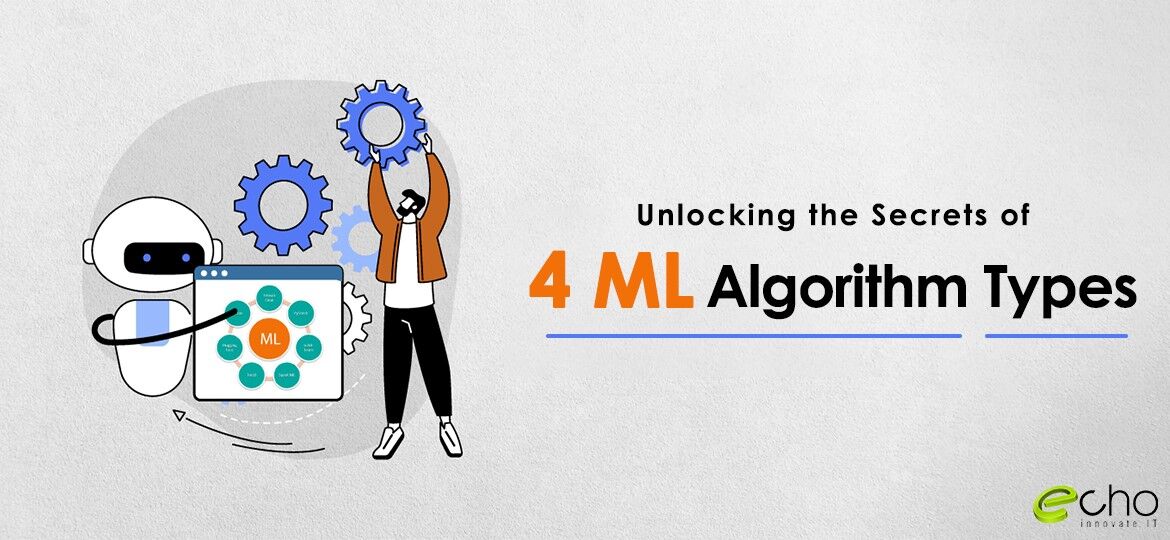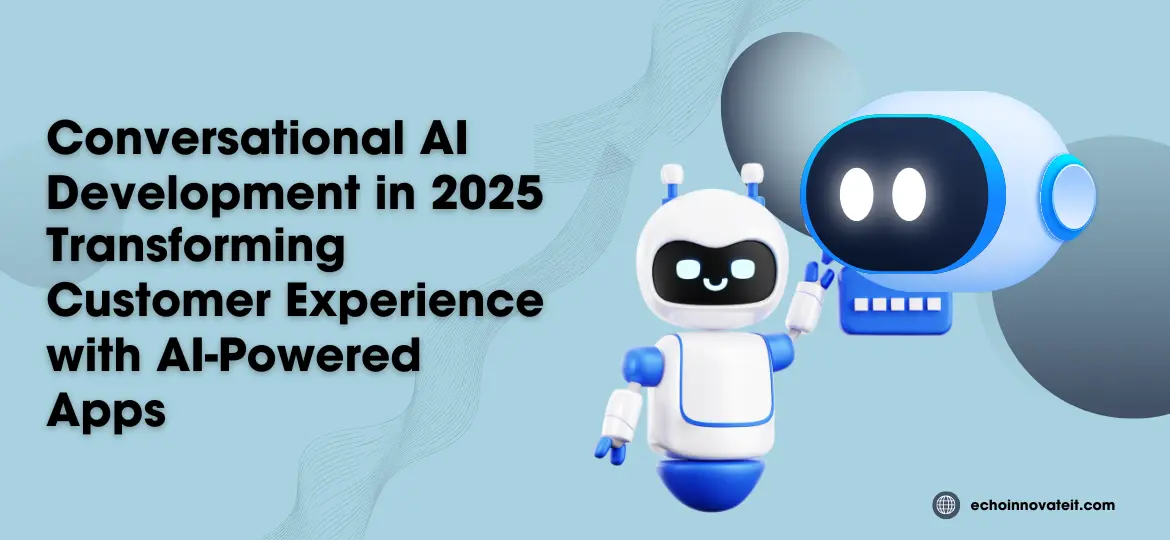Types of machine learning algorithms have evolved from a science fiction idea to the most accurate and diverse business method available, improving any business on multiple verticles. Its impact on the output of various businesses has grown to the point where high-quality machine learning algorithms are in need to ensure many industries’ survival in this sector.
Big Data applications would certainly play a significant role in potential technical advancements. Machine learning and artificial intelligence, on the other hand, are critical to unlocking the value of data. The following is a brief description of the relationship between the three big data is in use for materials, machine learning is a tool, and artificial intelligence is the result.
Why are machine learning algorithms so important?
Machine Learning refers to a machine’s ability (computers) to learn in the same way humans do. It is now commonly in use in daily life, for example, in self-driving cars and automated transportation, streamlined logistics, and delivery, optimizing elder care, and so on, to make our lives simpler.
Machine learning works in the same way that humans do. To give a machine (computer) the same learning ability as a human, “classification” is usually in consideration before analyzing, judging, and finally taking action.
Machine Learning is a process in which a computer algorithm finds a pattern in data and predicts the likely outcomes. Machine learning patterns are highly adaptable. They are constantly in the update as new data is introduced.
Four Types Of Machine learning algorithms
- Supervised learning,
- Unsupervised learning,
- Semi-supervised learning,
- Reinforcement learning
1. Supervised machine learning algorithms
Python’s fundamental characteristics make it a popular choice for web development.
Python is firstly free, open-source, and generally accessible. More significantly, it is also very adaptive. Employing Python web development enables developers to create websites using a variety of programming techniques.
In addition, it has dynamic typing capabilities. This simply implies that Python uses programs that do not need compilation (or translation) prior to execution. They are performed during runtime. This is advantageous for web app development in 2023 since it takes less code and simplifies debugging.
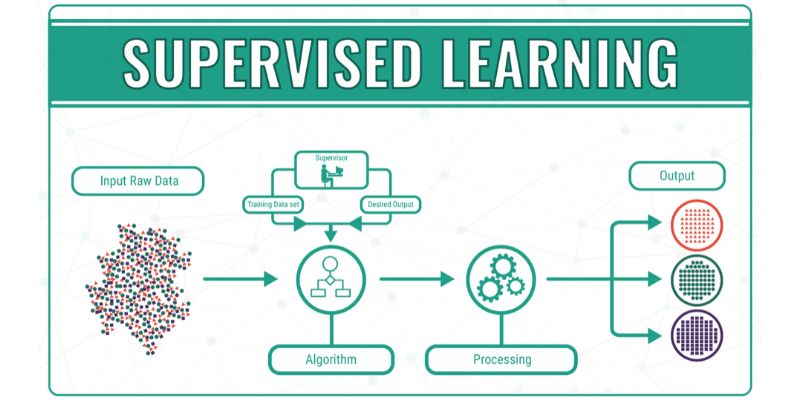
Supervised Learning Algorithms are the simplest of the four types of machine learning algorithms. These algorithms necessitate the model developer’s direct supervision. In this case, the developer labels the sample data corpus and establishes strict boundaries for the algorithm to operate within. All materials are “labeled” to provide the machine with the corresponding value, allowing it to predict the correct value. This method is primarily based on manual classification, which is the easiest for a computer and the most difficult for humans.
This method is analogous to providing a standard answer to the machine (computer). When the machine is officially tested, it will respond by the standard response, increasing reliability. If you want to train a machine to distinguish between elephants and giraffes, for example, you can provide 100 photos of elephants and giraffes. The machine detects elephant and giraffe characteristics based on “labeled” photographs and identifies elephants and giraffes based on their characteristics. Finally, it will correctly predict them.
The major process of supervised machine learning algorithms
Classification
Classification is the process of learning from previous data samples and manually training the model to predict binary outcomes (yes/no, true/false, 0/1). The classification algorithm recognizes and categorizes certain types of objects to predict one of two possible outcomes.
Regression
The process of identifying patterns and calculating predictions of continuous outcomes is regression. For example, forecasting house prices or sales for the following month.
Supervised Learning Algorithms use case
Equally important price prediction and trend forecasting are the most common applications for these algorithms in sales, retail commerce, and stock trading. These algorithms assess the possibility and calculate possible outcomes based on incoming data.
Unsupervised Machine Learning
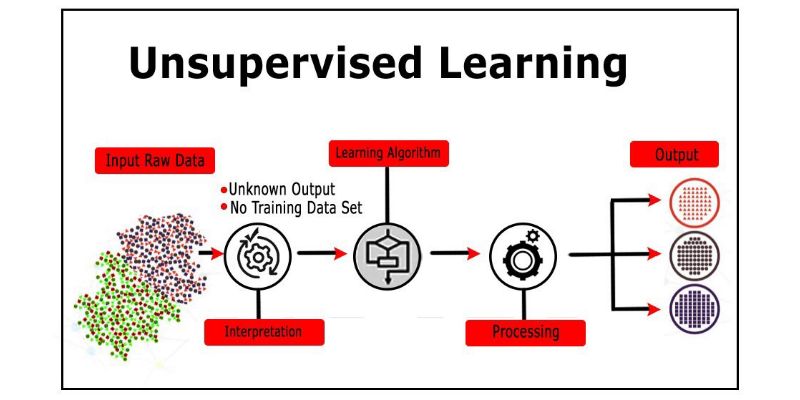
Equally important price prediction and trend forecasting are the most common applications for these algorithms in sales, retail commerce, and stock trading. These algorithms assess the possibility and calculate possible outcomes based on incoming data.
There are no labels on the materials, and the machine classifies them by detecting data characteristics. Manual classification is not in use in this method, which is the simplest for humans but the most difficult for the computer, resulting in more errors.
If unsupervised learning is used to identify elephants and giraffes, the machine must decide which of the 100 photos provided elephants are and which are giraffes while also performing the classification. The machine identifies which animal it is based on the characteristics and classification it detects in future predictions. However, machine-identified results are not required.
Unsupervised learning algorithms are not under the developer’s direct control. The main point of the requirement for supervised machine learning is that we must know the results of previous data to predict new data results. In the case of unsupervised machine learning algorithms, the desired results are unknown and yet to be defined.
The unsupervised machine learning algorithm is:
- To explore the structure of the information
- Pattern detection
- For extracting valuable insights
Process and apply techniques of unsupervised learning algorithms
Clustering
It is a data exploration technique in use to segment data into meaningful groups (i.e., clusters) based on internal patterns without prior knowledge of group credentials. Additionally, credentials are on the basis of the similarity of individual data objects and aspects of their dissimilarity to the rest.
Dimensionality reduction
In most cases, there is a lot of noise in the incoming data. Machine learning algorithms use dimensionality reduction to remove noise while distilling the relevant information.
3. Semi-supervised machine learning algorithms
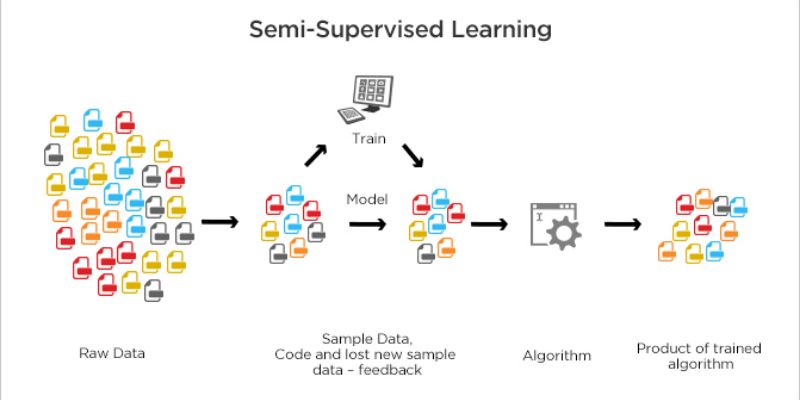
Semi-supervised learning algorithms fall somewhere between supervised and unsupervised learning algorithms. In essence, the semi-supervised model combines elements of both to form a new entity. Only a small amount of data is labeled. Computers only need to find features in labeled data and then classify other data based on those features.
This method, which is the most commonly, used, can improve prediction accuracy. If there are 100 photos, ten of them are elephants and ten are giraffes. The machine identifies and categorizes the remaining photos based on the characteristics of these ten photos. Because there is already a foundation for identification, predicted results are typically more accurate than unsupervised learning.
Semi-supervised algorithms and their works
A semi-supervised machine-learning algorithm shapes the operation’s requirements using a limited set of labeled sample data.
As a result of the limitation, a partially ready model is taken into use that is later in partner with labeling the unlabeled data. Because of the sample data set’s limitations, the results are pseudo-labeled data.
Finally, labeled and pseudo-labeled data sets are combined, resulting in a unique algorithm that combines descriptive and predictive aspects of supervised and unsupervised learning.
Use case of semi-supervised algorithms
Semi-supervised learning is used in the legal and healthcare industries, among others, to manage web content classification, and image and speech analysis. In the case of web content classification, crawling engines and content aggregation systems use semi-supervised learning. In both cases, it analyses content and arranges it in specific configurations using a large number of labels. However, for further classification, this procedure usually necessitates human intervention.
An algorithm performs labeling in image and speech analysis to provide a viable image or speech analytic model with coherent transcription based on a sample corpus. It could be an MRI or CT scan, for example. It is possible to provide a coherent model that can identify a target with a small set of good scans.
4. Reinforcement machine learning
Exploration/exploitation is a technique as a part of Reinforced ML. The mechanics are straightforward: the action occurs, the consequences take place, and the next action takes the first action’s outcomes into account. It’s a recursive algorithm.
The machine employs observations gleaned from interactions with the environment to take actions that maximize the reward or minimize the risk. There are no labeled materials when using reinforcement learning, but you can tell which step is correct and which step is incorrect. The machine gradually modifies its classification based on the feedback’s quality until it obtains the correct result.
Use case of a reinforcement learning algorithm
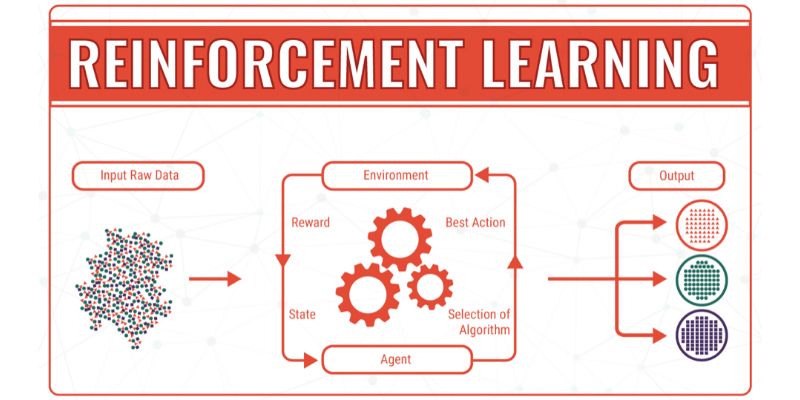
Strengthening Machine Learning is appropriate in situations of limited or inconsistent information available. In this case, an algorithm’s operating procedures come into existence on basis of interactions with data and relevant processes.
This type of machine learning model is frequently in use in video games. Reinforcement Learning allows the AI reactions to the player’s actions to be more flexible, resulting in more viable challenges. For example, the collision detection feature for moving vehicles employs this type of ML algorithm.
Reinforcement Learning is in use in Marketing and Ad Tech operations. By closely adapting to the user’s behavior and surrounding context, this type of machine learning algorithm can make retargeting operations much more flexible and efficient in delivering conversion.
Importance of algorithm
Machine Learning is a process in which a computer algorithm finds a pattern in data and predicts the likely outcomes. Machine learning patterns are highly adaptable. They are constantly updating on introducing new data.
The bottom line – Types of Machine Algorithms
As you can see, various types of machine learning algorithms solve various types of problems. Combining different algorithms creates a power capable of handling a wide range of tasks and extracting valuable insights from a wide range of data
FAQs
What algorithms are commonly used in supervised learning?
Classification algorithms:
Logistic Regression
Decision Trees and Random Forests
Support Vector Machines (SVM)
Naïve Bayes
k‑Nearest Neighbors (k‑NN)
Neural Networks
Regression algorithms:
Linear Regression, Ridge, Lasso
Support Vector Regression (SVR)
Tree-based regression and Gradient Boosting Machines (e.g., XGBoost, CatBoost)
What techniques fall under unsupervised learning?
Common methods include:
Clustering: k‑Means, Hierarchical Clustering, DBSCAN, Gaussian Mixture Models
Dimensionality Reduction: Principal Component Analysis (PCA), t‑SNE, ICA, UMAP
Association Rule Learning: Apriori, Eclat
Anomaly Detection: Isolation Forest, Local Outlier Factor
Latent Variable Models: Expectation-Maximization (EM), matrix decomposition like SVD or NMF
What is ensemble learning and how does it relate?
Ensemble learning combines multiple models to improve performance:
Bagging (e.g. Random Forest) reduces variance by averaging diverse models
Boosting (e.g. AdaBoost, XGBoost, CatBoost) focuses on correcting errors in successive learners
Stacking blends outputs of different algorithm types into a final meta-model
What are the main categories of machine learning?
There are three primary learning paradigms:
Supervised Learning – using labeled data for prediction tasks (classification/regression)
Unsupervised Learning – discovering hidden structures from unlabeled data
Reinforcement Learning – training agents to maximize rewards through interaction with an environment
